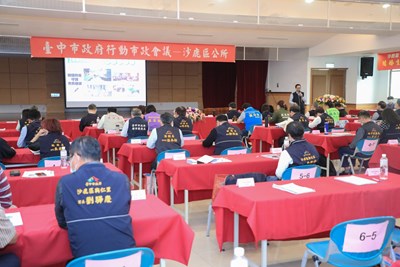
Taichung Port area, which is located in a low-lying area at the intersection of steep and gentle slopes, often suffers from flooding during the typhoon season due to the difficulty of drainage. This has consequently resulted in citizens’ losses in assets. To respond to local citizens’ expectations over the last forty odd years, Taichung City Government has, through its subordinated Water Resources Bureau, launched the three-phase “Nanshan Intercepting Drain Project” with the central government. With a total length of 9.4 km, this construction project extends from the south to the north until reaching Beishi River in Shalu District. Phase I and II have been successfully completed and the City Government continues to apply for a budget from the central government for Phase III. Today (the 19th) at the city council meeting, Mayor Lu Shiow-yen expressed that, upon completion of Phase III, the flooding issues in coastline areas, including Shalu, Wuqi and Longjing, will all be solved. In addition, this three-phase project, which is expected to improve the conditions of the 367-ha flood-prone area and protect 19,000 citizens, will be an important flood protection infrastructure that guards the coastline.
Today’s mobile city council meeting was moved to Shalu District Office and Director of Water Resources Bureau Fan Shi-yi presented the Coastline Nanshan Intercepting Drain Plan and Taichung City Water Conservancy Construction Results. This project is divided into three phases: Phase I aims to broaden the downstream river with a total budget of NT$2.6 billion, which involved connecting the Longjing drain confluence points to Nanshihkeng River first and then broadening the downstream river from 25 m to 40 m for 4.7 km. Phase II is to construct a 2.9 km long drainage system between Nanshihkeng River and Beishihkeng River with a total budget of NT$2.4 billion. Phase III, is to develop the area between Beishihkeng River and the upstream Zhulinbei River with a total length of 2.9 km. The construction of Phase III is in the planning stage and the City Government will continue to seek for budget from the central government in order to facilitate its launch and promotion of it. The total budget of Phase III is expected to be NT$6.5 billion.
Director Fan expressed that, affected by greenhouse effects and global warming, the past river improvement approach of “having no flooding” had gradually shifted to a resilience strategy of “flood preparation” and “rapid flood drainage”. With respect to flood-prone areas that require urgent improvement, the Bureau will review and replan the drainage system with the aspiration to meet the public’s actual needs. Apart from building hardware infrastructure to regulate rivers and watercourses, the Bureau will also cooperate with local agencies to promote the establishment of symbiosis between water conservancy engineering and local culture across regions in order to link the historical-cultural context and lifestyles, and reshape the water culture of all regions.
During this briefing of district affairs today, Chief of Shalu District Liao Tsai-Tsung also pointed out that, as Phase II of the Nanshan Intercepting Drain Project passed through important roads and highly populated areas in Shalu District, the originally adopted open-cut method had been partially modified to the shield method and that the Shalu section was completed at the end of last year. In addition, the City Government has also been proactive in improving the drainage system in Nanshih Village, Lifen Village, Sanlu Village, Liulu Village, Nanshi Village, Liulu Village and Luoquan Village to gradually address the flooding issue in these regions.
The Chairperson of Research, Development and Evaluation Commission Wu Huang-sheng also made a report in regard to proposals made by village chiefs and the implementation progress in their region: The flashing light at the intersection of Qingquan Road and Yinghuadajun was changed to the three-color traffic light on December 8, 2020; the location of Meiren Village community activity center has been negotiated; the small-amount purchase of surveillance systems to be used in the villages has been discussed, and; the accessibility of setting up an MRT Blue Line station at the intersection of Taiwan Boulevard (Section 6) and Zhengying Road has been evaluated. The implementation of all infrastructure projects has been accelerated and carried out based on local feedback in order to continuously enhance local living quality. (4/19*6)* Water Resources Bureau

 Facebook
Facebook
 Twitter
Twitter
 LINE
LINE